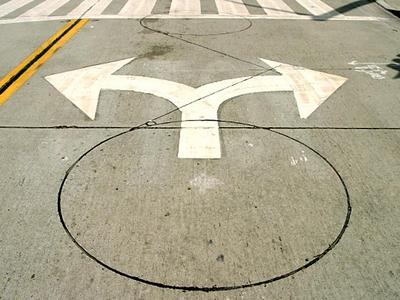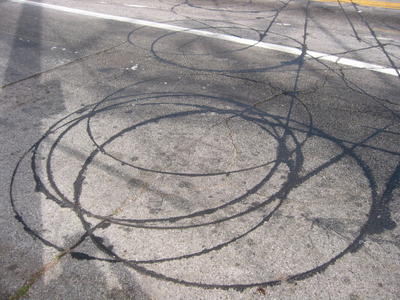The geometry of traffic control

The bewilderingly complex world of Los Angeles traffic control was explored last year at the Center for Land Use Intrepretation, in an exhibition called "Loop Feedback Loop: The Big Picture of Traffic Control in Los Angeles."
As part of the monumental and continuous task of keeping the city's vehicle fleet moving, "the highway and surface street network of Los Angeles has become the most instrumented and managed of any American city."

Its surfaces carefully painted and inlaid with sensors, its intersections programmed from afar, the Los Angeles road network is not unlike an immersive, 24-hour experimental film set. It is a counter-Hollywood, constantly filmed – a paparazzi for empty concrete – and its main actors are the surfaces of roads. All of this is overseen by a rotating staff of technicians who sip coffee and watch for "incidents" in secure, air-conditioned control rooms.
These rooms are where new scenes in the great and secret show of Los Angeles are recorded everyday.

It's a kind of metropolitan nervous system, an intelligent city, the urban dreams of Futurists made (almost) real: "Increasingly automated, signals also flow out from these control rooms, adjusting timings of lights at intersections and freeway metering ramps, dispatching incident response teams, and updating traffic reports, including live maps on the web. These in turn effect the flow, feeding back into the system and changing its form, as indicated by the sensors that send their signals to the control rooms: the loops feeding back to the loops."

These loops are literal: they're called inductive loops, and they're magnetically active zones of the road that detect the presence of large metallic bodies – cars, in other words, that have stopped at a light and are waiting.


All of this information – scientifically registered, studied, and saved – is monitored in real-time; and, as anyone who has seen the remake of The Italian Job knows, the true public life of Los Angeles is played out on walls of monitors, screened by private security firms, given order and sense where there can still be the illusion of control.
The highway as reality TV.



The city, in unedited time.





Comments are moderated.
If it's not spam, it will appear here shortly!
As a side note, the automated inductive loops cause my friend and his motorcycle no end of headache.
The electromagnetic loop created by it does indeed notice large bodies of metal and adjust the traffic lights accordingly, but sometimes my friend's motorcycle isn't big enough to register ie. the light never changes. (He's especially fond of this happening in the middle of the night w/ no other traffic around). He later figured out that turning off the engine and restarting it creates a big enough electric signature to make the loop notice him and his vehicle and adjust the light accordingly. The system may be fully automated but it's not sentient just yet.
Yet is the key word. All of LA's sprawling anatomy of freeways and cloverleaf junctions arises with a tectonic shiver from the arid sands of southern California, artificially intelligent, blinking with traffic lights, and it wanders free into the American desert. Shining. A kind of moving, hyperdimensional squid made of asphalt and miswired traffic control programs shambling into the mountains, raining cars. Coming soon to a desert near you.
Perhaps, meanwhile, your friend should take to biking round with very large blocks of metal... In lieu of the gym: a mobile fitness regime. Huge biceps within days. Or very large earrings, perhaps.
(And can you hack these intersections with large magnets? Reprogram the city.)
Something of a tangent again, but it was truly fascinating to visit New Mexico a few years back to see how people/architecture spreads out horizontally in all directions when you're surrounded by desert. Climbing up to a high point revealed how wide everything truly was. And there were no highrises to speak of... Living in London with it's archaic road system that was obviously designed for thin horses and not wide cars (much less double-decker buses) makes me truly appreciate the fundamentally different paradigms in urban planning.
New Mexico also (well Albuquerque) looks like place designed by machines. Lots of straight angles that make the entire city look like a huge grid made up of building-units and ever shifting cars moving in harmonious patterns. From high above I can imagine the cars looking not unlike small bursts of electrity moving along a geometrically perfect circuitboard... Undoubtedly to be assimilated into the wandering AI/LA squid...
Fun. Still gridlock though. If LA got up and walked into the desert at least we'd finally get somewhere.
Your friend might have some luck riding along the side of the loop. Here in Christchurch the council is intermittantly nice to cyclysts, and all of the cycle lanes and paths have these loops, but they're narrow enough that they've had to mark them with three white diamonds. Even on normal roads the loops are very often split into two, and the half-wide loops can somtimes be tripped with a push bike, riding near to the wire seems to help.
A large mass is not required to trip the loop detector. What you do need however is a large conductive loop positioned over the right place in a sensor. Cars have no problem since they're made of metal and the whole chassis can form an electrical loop in many places. Bicycles need to take a little more effort as the cyclist from Christchurch mentioned : positioning the wheel on the edge of the loop usually works. Or in the figure-8 design loops, position the wheel over the center wire.
Much of this depends on whether the traffic engineers have tuned the loops properly. A well tuned loop can even detect a delicate 27" loop of wire weighing less than a gram (which is a great solution if you ride a bike equipped with carbon fiber wheels)
Post a Comment